| Article ID | Journal | Published Year | Pages | File Type |
|---|---|---|---|---|
| 2408686 | Vaccine | 2006 | 5 Pages |
Mathematical modelling provides useful insight into the geographic and temporal spread of pandemic influenza. It has been recently used to assess the ability to stop a pandemic at a very early stage. Here, we model the global diffusion of pandemic influenza and the impact of available preventive and control measures. We refined a published SEIR deterministic model of disease dynamics within 52 cities interconnected via air transport to simulate the impact of five interventions in a variety of scenarios: vaccination, case isolation, therapeutic and prophylactic antiviral treatment, and air traffic reduction. The impact of these measures was assessed on the spread of a potential pandemic strain profile, with an average attack-rate of 26%, a case-fatality rate of 2.5% and a residual immunity of 25%.Our analysis highlighted the importance of: (1) a global perspective for dealing with pandemic risks; (2) the time factor and, hence, the importance of surveillance systems; (3) the complementary role of available control measures. Results provide general guidance for the issues of concern to public-health decision-makers: when to set up interventions, where, and at which administrative levels.
